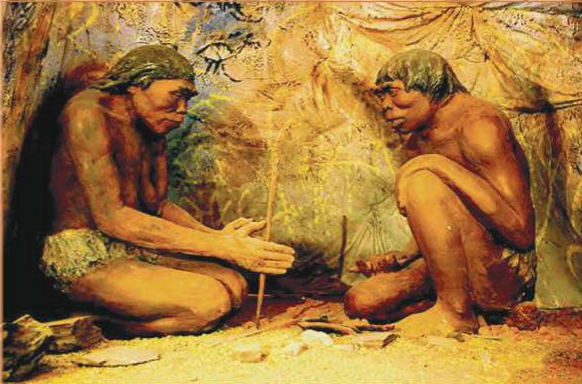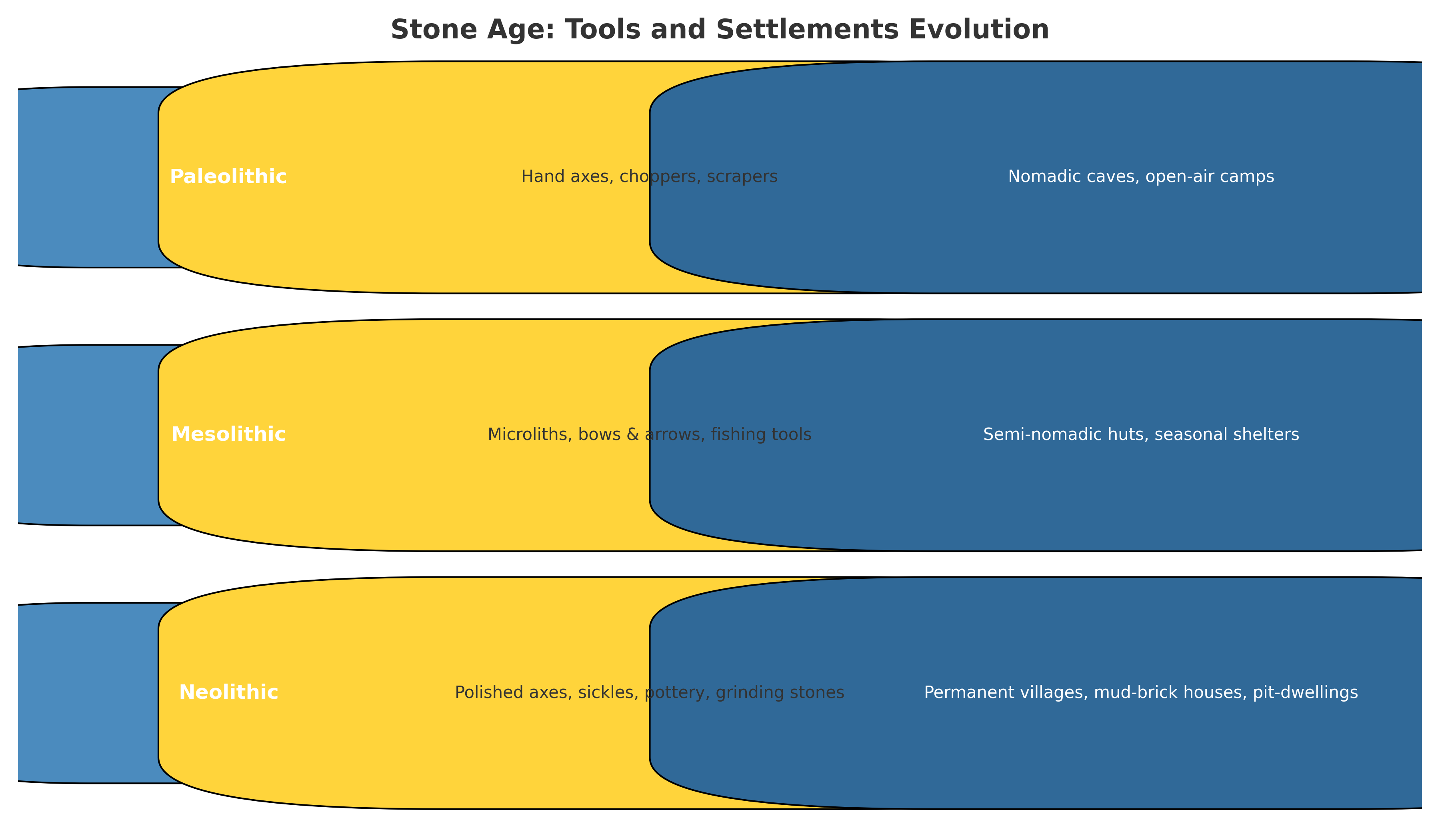Ancient History Playlist
11 chapters • 0 completed
Stone age
5 topics
Chalcolithic age(Copper Age)
2 topics
Indus Valley Civilization
5 topics
Vedic age
15 topics
The Mahajanapadas
8 topics
Buddhism and Jainism
16 topics
Mauryan Empire
11 topics
Post-Mauryan Period
14 topics
Gupta Period
16 topics
Post-Gupta Period
16 topics
Sangam Age
7 topics
Chapter 1: Stone age
Chapter TestPre-Historic Period: Introduction
Human history is divided into Prehistory, Protohistory, and History, based on the availability of written records. Prehistoric times are known only through archaeology, protohistoric times through archaeology and limited deciphered inscriptions, and historical times through fully deciphered written sources.
Human history is divided into Prehistory, Protohistory, and History, based on the availability of written records. Prehistoric times are known only through archaeology, protohistoric times through archaeology and limited deciphered inscriptions, and historical times through fully deciphered written sources.
Difference between Prehistory, Protohistory, and History
| Stage | Definition | Example (India) |
|---|---|---|
| Prehistory | No knowledge of writing; only archaeological remains | Paleolithic, Mesolithic, Neolithic cultures |
| Protohistory | Script existed but undeciphered; archaeology main source | Indus Valley Civilization |
| History | Written records available and deciphered | Vedic Age, Mauryan period |
Fun Facts
The word 'History' comes from the Greek 'Historia' meaning inquiry or investigation.
Prehistoric humans left behind cave paintings (like Bhimbetka in India) instead of writing.
The Harappan script is one of the world’s major undeciphered scripts, keeping Protohistory mysterious.
Ashoka’s edicts are the earliest deciphered written records in Indian history.
Mains Key Points
Prelims Strategy Tips
Sources for the Construction of History
The reconstruction of history depends on various sources such as archaeological findings, inscriptions, coins, and literary texts. Each source provides unique information about polity, society, economy, culture, and religion of the past.
The reconstruction of history depends on various sources such as archaeological findings, inscriptions, coins, and literary texts. Each source provides unique information about polity, society, economy, culture, and religion of the past.
Sources of History
| Source Type | Examples | Information Provided |
|---|---|---|
| Archaeology | Harappa, Bhimbetka | Life of prehistoric & protohistoric people |
| Epigraphy | Ashokan edicts, Prayaga Prashasti | Royal orders, land grants, administration |
| Numismatics | Punch-marked coins, Gupta gold coins | Trade, economy, rulers’ achievements |
| Literature | Vedas, Arthashastra, Sangam poems, Indica | Society, polity, economy, culture |
| Art & Architecture | Ajanta paintings, Sanchi stupa | Religious life, cultural expression |
Fun Facts
India has more than 100,000 inscriptions recorded, making it one of the richest epigraphic traditions in the world.
Punch-marked coins (PMCs) carry multiple symbols like sun, animals, trees — not kings’ names.
The Periplus of the Erythraean Sea (1st century CE) is a Greek text describing Indian ports and trade.
Ajanta cave paintings (Gupta period) are called ‘encyclopedia of contemporary life’.
Mains Key Points
Prelims Strategy Tips
Stone Age
The Stone Age refers to the prehistoric period when humans primarily used stone tools. It is divided into three phases: Paleolithic, Mesolithic, and Neolithic. This age shows the transformation of human life from hunting-gathering to agriculture and settled communities.
The Stone Age refers to the prehistoric period when humans primarily used stone tools. It is divided into three phases: Paleolithic, Mesolithic, and Neolithic. This age shows the transformation of human life from hunting-gathering to agriculture and settled communities.

Phases of Stone Age
| Phase | Time Period | Key Features | Major Sites in India |
|---|---|---|---|
| Paleolithic | 2 million – 10,000 BCE | Hunting-gathering, cave dwelling, crude stone tools, fire discovery | Soan Valley, Bhimbetka, Kurnool caves |
| Mesolithic | 10,000 – 8,000 BCE | Microliths, semi-nomadic, early domestication, cave paintings | Bhimbetka, Bagor, Adamgarh |
| Neolithic | 8,000 – 3,000 BCE | Agriculture, settled life, pottery, polished tools, weaving | Mehrgarh, Burzahom, Chirand, Daojali Hading |
Fun Facts
Bhimbetka cave paintings are believed to be over 30,000 years old.
Burzahom site in Kashmir shows dog burials along with humans, indicating ritual practices.
Neolithic people used grinding stones for processing grains, which is still used in rural India.
Some Neolithic sites show evidence of early rice cultivation in Eastern India.
Mains Key Points
Prelims Strategy Tips
Stone Age Tools and Settlements
Stone Age humans developed tools made of stone, bone, and wood, which evolved over time from crude hand-axes to polished tools. Settlements also evolved from temporary caves and open-air sites to permanent agricultural villages.
Stone Age humans developed tools made of stone, bone, and wood, which evolved over time from crude hand-axes to polished tools. Settlements also evolved from temporary caves and open-air sites to permanent agricultural villages.

Stone Age Tools and Settlements
| Phase | Tools | Settlement Type | Major Sites |
|---|---|---|---|
| Paleolithic | Hand axes, choppers, scrapers, bone tools | Nomadic, caves, open-air camps | Bhimbetka, Kurnool caves, Soan Valley |
| Mesolithic | Microliths, bows & arrows, fishing tools | Semi-nomadic, seasonal huts & shelters | Bhimbetka, Bagor, Adamgarh |
| Neolithic | Polished axes, sickles, grinding stones, pottery | Permanent villages, mud-brick houses, pit-dwellings | Mehrgarh, Burzahom, Chirand, Daojali Hading |
Prelims Strategy Tips
Significance of the Prehistoric Period
The prehistoric period marks the evolution of humans from nomadic food-gatherers to settled agriculturists. It was during this time that basic technologies, social organization, art, and culture first appeared, laying the foundation for later civilizations.
The prehistoric period marks the evolution of humans from nomadic food-gatherers to settled agriculturists. It was during this time that basic technologies, social organization, art, and culture first appeared, laying the foundation for later civilizations.
Significance of Prehistoric Period
| Aspect | Significance |
|---|---|
| Human Evolution | Shift from hunters to farmers; adaptation to environment |
| Technology | Stone tools, fire, wheel, pottery, early metals |
| Art & Culture | Cave paintings, megaliths, rituals |
| Social Organization | From nomadic groups to settled villages; division of labor |
| Economy | Agriculture, animal domestication, early trade |
Fun Facts
The Bhimbetka caves in Madhya Pradesh have paintings as old as 30,000 years, some showing animals and hunting scenes.
The wheel, discovered in the prehistoric age, is considered the single greatest invention in human history.
Megalithic burials in South India often contain pottery, iron tools, and ornaments, showing belief in afterlife.
Domestication of animals like dogs, cattle, and goats transformed food security and transport.
Mains Key Points
Prelims Strategy Tips
Chapter Complete!
Ready to move to the next chapter?
